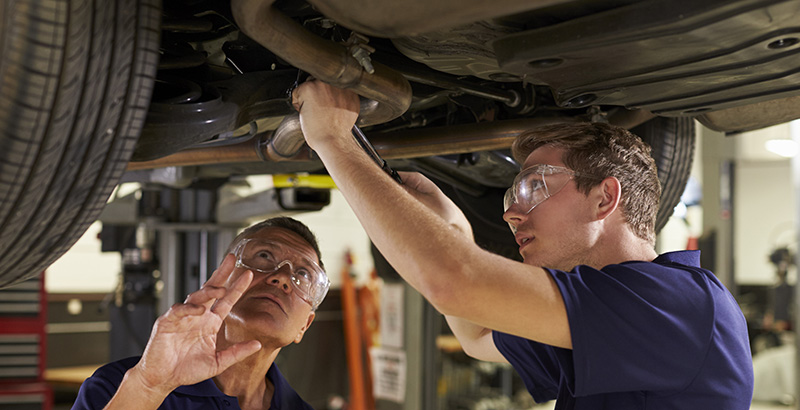Batel: Rethinking the School-to-Work Pipeline With Career and Technical Education That Is Rigorous, Inclusive, and Equitable

Today’s modern economy brings with it modern challenges. Significant job growth in fields like health care and computer science requires a greater share of the workforce to have some type of postsecondary degree or training. To equip students — particularly those from underserved communities — for this reality, states, districts, and schools must rethink the pipeline from school to work.
Career and technical education (CTE) is one path forward. Over the past four years, media mentions of CTE have quadrupled. In 2017, 49 states and Washington, D.C., enacted more than 200 new policies related to CTE and career readiness. This year, at least one-third of governors prioritized workforce development and CTE in their State of the State addresses — and for good reason.
CTE prepares students to succeed after high school by creating a link between what happens inside the classroom and what happens on the job. Rigorous programs of study, or sequences of coursework that culminate in a certificate or credential; apprenticeships that combine on-the-job training with classroom instruction; and work-based learning experiences provide students with the skills they need for middle-class jobs or postsecondary education and training.
The possibilities for rethinking CTE are extensive, but schools need strategies that mix flexibility and autonomy with their own creativity. A number of public charter schools, for example, are leveraging their autonomy to create promising CTE programs. Da Vinci Schools — which largely serve students from socioeconomically disadvantaged backgrounds in Los Angeles — designed themed high schools where students can choose from career pathways in the sciences or communications fields. The charter network also partnered with business leaders to create real-world curriculum and offer learning opportunities: Students can go from building robots in school to interning at SpaceX.
Not only do these experiences increase student engagement, they can also improve student outcomes. Research, though limited, finds that high school CTE programs are associated with higher future employment and earnings. A recent study in Massachusetts found that participation in the state’s regional vocational and technical high schools, where students split time between the classroom and technical programs, significantly increases the likelihood of graduating on time. Notably, the study suggests larger positive effects for lower-income students than their higher-income peers. Students with disabilities in these schools are also more likely to graduate in four years than their counterparts at traditional high schools.
Worcester Technical High School, one of the 36 regional vocational and technical high schools in Massachusetts, supports a large high-needs population and organizes student learning around four academies: design and engineering, health and human services, construction technology, and IT and business services. Students can participate in the Tufts at Tech veterinary teaching clinic, work at the student-run Skyline Bistro, and train at the school’s full-service bank. The school, which once struggled academically, has since made huge gains, receiving the state’s highest accountability rating in 2017.
Such successes are not unique to Massachusetts. In Philadelphia, CTE schools have had a positive impact on high school graduation and postsecondary enrollment rates in two- and four-year colleges. Today, the School District of Philadelphia offers over 120 CTE programs in more than 30 high schools. For example, at the WorkShop School — a citywide-admission high school in West Philadelphia that primarily serves low-income families — students have the opportunity to choose from three certified programs of study: pre-engineering, automotive technology, and auto body and collision repair.
To be sure, CTE is not new. The first federal law to provide funding for vocational education was passed more than 100 years ago. But CTE today is, and needs to be, more modern than outdated voc-ed models of the past that too often failed to prioritize student learning or transitions into the labor market. Current programs can prepare students for a wide variety of fields — many of which require some type of postsecondary education — with support from both sides of the aisle.
With more states, districts, and schools prioritizing this work, it is crucial that they make a direct connection between the learning opportunities they offer and labor market demands. Districts and schools should collaborate with local industry partners to design relevant CTE pathways, courses, and curricula, and expand student access to work-based learning. Districts and schools should also engage stakeholders such as community and four-year colleges and workforce system leaders to strengthen pipelines among secondary education, postsecondary education, and the workforce.
Additionally, states and localities must ensure that programs are not only rigorous but also inclusive and equitable. Students should have access to a range of high-quality coursework and experiences that prepare them for both postsecondary education and a career based on interest, not demographics. And to make this happen, states and districts must provide schools with the resources they need to serve their students well.
As demand for these programs continues to grow, high schools interested in incorporating CTE inside and outside the classroom have a variety of models from which to choose. But while school governance structures and course offerings may vary, high-quality CTE programs must all have one thing in common: increased opportunity for students to succeed in today’s economy.
Samantha Batel is a policy analyst with the K-12 Education team at the Center for American Progress, focusing on school standards, school and district accountability, and school improvement. Previously, she was a confidential assistant at the U.S. Department of Education in the Office of Elementary and Secondary Education.
Get stories like these delivered straight to your inbox. Sign up for The 74 Newsletter

;)